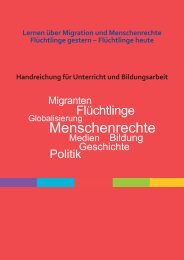IMMIGRATION IN ITALY By Laura Zanfrini* 1. From a source to a ...
IMMIGRATION IN ITALY By Laura Zanfrini* 1. From a source to a ...
IMMIGRATION IN ITALY By Laura Zanfrini* 1. From a source to a ...
- No tags were found...
Create successful ePaper yourself
Turn your PDF publications into a flip-book with our unique Google optimized e-Paper software.
There are no doubts that the massive inclusion of immigrant workforce is one of the majorelements characterizing the changes occurred in the last decades in the Italian labour market. Sincethe beginning of the 1990s, the number of both active and employed migrant workers have beencontinuously growing, conferring <strong>to</strong> the Italian labour market a more and more evident multi-ethniccomposition [see Table 4].Tab. 4 – Employed workers per economic activity sec<strong>to</strong>r, gender and geographical areas. Absolute values(thousands of units). Year 2012Comm.Total Agricult.TotalindustryBuildingindustryManuf.industryTertiaryindustryandtrade OthersItalians 20,564.7 734.5 5,59<strong>1.</strong>6 1,422.3 4169.3 14,238.6 4,232.6 10,006.0Italy Foreign. 2,334.0 114.6 770.4 33<strong>1.</strong>7 438.7 1449.0 418.4 1,030.6Total 22,898.7 849.1 6,362.0 1,754.0 4608.0 15,687.6 4,65<strong>1.</strong>0 11,036.6Italians 10,50<strong>1.</strong>7 273.8 3,360.5 69<strong>1.</strong>8 2668.7 6,867.4 2,09<strong>1.</strong>9 4,775.4North Foreign. 1,398.8 4<strong>1.</strong>2 54<strong>1.</strong>3 192.1 349.2 816.3 22<strong>1.</strong>4 594.9Total 11,900.6 315.0 3,90<strong>1.</strong>8 883.9 3017.9 7,683.7 2,313.3 5,370.4Italians 6,010.0 11<strong>1.</strong>2 1914.8 405.9 1508.8 3,984.0 1,160.2 2,824.0Foreign. 803.2 17.6 288.0 112.6 175.5 497.5 12<strong>1.</strong>1 376.4North-WestNorth-EastCanterTotal 6,813.2 128.8 2,202.8 518.5 1684.3 4,48<strong>1.</strong>5 1,28<strong>1.</strong>3 3,200.2Italians 4,49<strong>1.</strong>7 162.6 1,445.7 285.9 1159.9 2,883.4 93<strong>1.</strong>7 1,95<strong>1.</strong>7Foreign. 595.6 23.6 253.2 79.5 173.7 318.8 100.3 218.5Total 5,087.4 186.2 1,699,0 365.4 1333.5 3,202.2 1,032.0 2,170.2Italians 4,195.3 87.3 976.6 265.3 71<strong>1.</strong>4 3,13<strong>1.</strong>4 867.8 2,263.5Foreign. 622.5 28.0 170.4 10<strong>1.</strong>3 69.1 424.0 116.5 307.5Total 4,817.8 115.3 1,147.1 366.6 780.5 3,555.3 984.3 2,57<strong>1.</strong>0Italians 5,867.6 373.3 1,254.4 465.2 789.2 4,239.8 1,272.8 2,967.0Foreign. 312.7 45.3 58.7 38.2 20.5 208.7 80.5 128.1SouthTotal 6,180.3 418.7 1,313.1 503.4 809.7 4,448.5 1,353.3 3,095.1Source: Eurostat, 2012This growth hasn’t been broken up even during the present economic recession. The impac<strong>to</strong>f the crisis on immigration has proved <strong>to</strong> be more soft than in other countries, thus revealing thepeculiarities but also the weakness of the Italian labour market. Suffice <strong>to</strong> observe that, from 2005<strong>to</strong> 2012, employed migrants had almost doubled, and during the most acute phases of the crisis, theoverall employment has increased thanks solely <strong>to</strong> the foreign component. The additional foreignemployment that has been produced in these turbulent years amounts <strong>to</strong> over one million; i.e., avolume significant enough <strong>to</strong> force us <strong>to</strong> face the question of its consequences for the Italianworkforce. What is certain is that the substantial need for foreign labour expressed by Italianfamilies – for tasks decidedly unattractive <strong>to</strong> most of the native labour force – is not enough byitself <strong>to</strong> account for the extraordinary absorption capacity demonstrated by Italian economy.In order <strong>to</strong> explain migrants’ occupational performance we can suggest that the law qualitywhich is a distinctive mark of migration in Italy, has contributed “<strong>to</strong> protect” migrants. Actually,despite some initial signals <strong>to</strong>wards a qualitative labour improvement and up-grading, the crisisended up in a downward realignment of the employment structure, the deterioration of the overallemployment quality and a growth in the number of low-salaried jobs. <strong>By</strong> affecting mainly low-skilloccupations and more traditional sec<strong>to</strong>rs, the new jobs created exacerbated the traditional forms ofsegregation by gender and nationality. Actually, the distribution of employed workers byoccupation [Table 5] clearly demonstrates migrants’ segregation in the lowest levels of the jobs’hierarchy in all the years for which data are available.As data reported in Table 5 clearly demonstrate, employed foreigners’ distribution outlines anoverall picture characterized by substantial immobility. Certainly, at an individual level, there areseveral examples of upward mobility processes, which take shape as migra<strong>to</strong>ry seniority grows, andoutline the paths <strong>to</strong> emulate. However, at a general level, the needs expressed by firms and familiesseem <strong>to</strong> unavoidably reroute foreign labour <strong>to</strong>wards those segments which are already widely<strong>Laura</strong> Zanfrini, Immigration in Italy, June 30, 2013. 13







